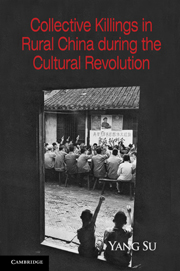Book contents
- Frontmatter
- Contents
- List of Figures
- List of Tables
- Preface and Acknowledgments
- 1 Kill Thy Neighbor
- 2 On the Record
- 3 Community and Culture
- 4 Class Enemies
- 5 Mao's Ordinary Men
- 6 Demobilizing Law
- 7 Framing War
- 8 Patterns of Killing
- 9 Understanding Atrocities in Plain Sight
- Appendix: Methodological Issues and Statistical Analyses
- References
- Index
9 - Understanding Atrocities in Plain Sight
Published online by Cambridge University Press: 05 June 2012
- Frontmatter
- Contents
- List of Figures
- List of Tables
- Preface and Acknowledgments
- 1 Kill Thy Neighbor
- 2 On the Record
- 3 Community and Culture
- 4 Class Enemies
- 5 Mao's Ordinary Men
- 6 Demobilizing Law
- 7 Framing War
- 8 Patterns of Killing
- 9 Understanding Atrocities in Plain Sight
- Appendix: Methodological Issues and Statistical Analyses
- References
- Index
Summary
The twin tasks of this book are to make historical and theoretical cases about collective killings in the countryside during the Cultural Revolution. I want to explain what happened and why. For the historical case, I establish the facts and patterns of collective killings in 1967 and 1968 in two provinces during the Cultural Revolution. I also document key aspects of Maoism between the 1949 revolution and the eve of the extreme atrocities. These aspects – the formation and transformation of a rural culture, the creation and maintenance of a class divide, the social mobility of the rural population, and the demobilization of legal institutions – provide a historical narrative and backdrop for understanding the collective killings. A central theme in this narrative is “actually existing Maoism”: a set of practices that were not only inspired by the communist ideology but also shaped by real-life challenges and contradictions. The leaders, their cadres, and ordinary citizens did not follow a master plan in the revolutionary transformations but rather reacted to reality – in specific times and places – in a pragmatic and often ad hoc fashion, improvising as they went along. In this context, collective killings, like many other actions, were emergent actions rather than part of routine politics. The overall nature of the regime and its explicit policies are insufficient to account for these emergent outcomes.
- Type
- Chapter
- Information
- Publisher: Cambridge University PressPrint publication year: 2011

